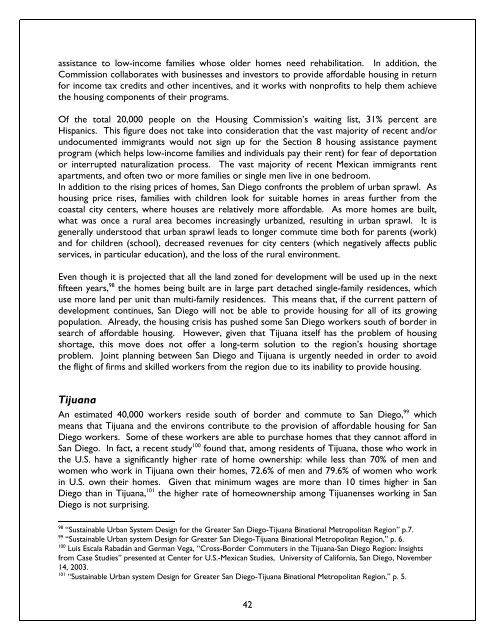Blurred Borders - International Community Foundation
Blurred Borders - International Community Foundation
Blurred Borders - International Community Foundation
You also want an ePaper? Increase the reach of your titles
YUMPU automatically turns print PDFs into web optimized ePapers that Google loves.
assistance to low-income families whose older homes need rehabilitation. In addition, the<br />
Commission collaborates with businesses and investors to provide affordable housing in return<br />
for income tax credits and other incentives, and it works with nonprofits to help them achieve<br />
the housing components of their programs.<br />
Of the total 20,000 people on the Housing Commission’s waiting list, 31% percent are<br />
Hispanics. This figure does not take into consideration that the vast majority of recent and/or<br />
undocumented immigrants would not sign up for the Section 8 housing assistance payment<br />
program (which helps low-income families and individuals pay their rent) for fear of deportation<br />
or interrupted naturalization process. The vast majority of recent Mexican immigrants rent<br />
apartments, and often two or more families or single men live in one bedroom.<br />
In addition to the rising prices of homes, San Diego confronts the problem of urban sprawl. As<br />
housing price rises, families with children look for suitable homes in areas further from the<br />
coastal city centers, where houses are relatively more affordable. As more homes are built,<br />
what was once a rural area becomes increasingly urbanized, resulting in urban sprawl. It is<br />
generally understood that urban sprawl leads to longer commute time both for parents (work)<br />
and for children (school), decreased revenues for city centers (which negatively affects public<br />
services, in particular education), and the loss of the rural environment.<br />
Even though it is projected that all the land zoned for development will be used up in the next<br />
fifteen years, 98 the homes being built are in large part detached single-family residences, which<br />
use more land per unit than multi-family residences. This means that, if the current pattern of<br />
development continues, San Diego will not be able to provide housing for all of its growing<br />
population. Already, the housing crisis has pushed some San Diego workers south of border in<br />
search of affordable housing. However, given that Tijuana itself has the problem of housing<br />
shortage, this move does not offer a long-term solution to the region’s housing shortage<br />
problem. Joint planning between San Diego and Tijuana is urgently needed in order to avoid<br />
the flight of firms and skilled workers from the region due to its inability to provide housing.<br />
Tijuana<br />
An estimated 40,000 workers reside south of border and commute to San Diego, 99 which<br />
means that Tijuana and the environs contribute to the provision of affordable housing for San<br />
Diego workers. Some of these workers are able to purchase homes that they cannot afford in<br />
San Diego. In fact, a recent study 100 found that, among residents of Tijuana, those who work in<br />
the U.S. have a significantly higher rate of home ownership: while less than 70% of men and<br />
women who work in Tijuana own their homes, 72.6% of men and 79.6% of women who work<br />
in U.S. own their homes. Given that minimum wages are more than 10 times higher in San<br />
Diego than in Tijuana, 101 the higher rate of homeownership among Tijuanenses working in San<br />
Diego is not surprising.<br />
98 “Sustainable Urban System Design for the Greater San Diego-Tijuana Binational Metropolitan Region” p.7.<br />
99 “Sustainable Urban system Design for Greater San Diego-Tijuana Binational Metropolitan Region,” p. 6.<br />
100 Luis Escala Rabadán and German Vega, “Cross-Border Commuters in the Tijuana-San Diego Region: Insights<br />
from Case Studies” presented at Center for U.S.-Mexican Studies, University of California, San Diego, November<br />
14, 2003.<br />
101 “Sustainable Urban system Design for Greater San Diego-Tijuana Binational Metropolitan Region,” p. 5.<br />
42















